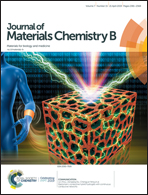MoS2 quantum dots as a unique fluorescent “turn-off–on” probe for the simple and rapid determination of adenosine triphosphate†
Abstract
We report a one-step hydrothermal method for the preparation of fluorescent molybdenum disulfide quantum dots (MoS2 QDs) and demonstrate the feasibility of fluorescent “turn-off–on” sensing of adenosine triphosphate (ATP) by using the MoS2 QDs. MoS2 QDs having strong blue-green fluorescence at 506 nm and good water-solubility were successfully synthesized by using ammonium tetrathiomolybdate as a single precursor. The fluorescence of MoS2 QDs was first quenched by Fe3+ through the formation of a MoS2 QDs/Fe3+ complex. ATP with the ability to coordinate with Fe3+ caused the dissociation of MoS2 QDs/Fe3+, resulting in the final release of MoS2 QDs and the recovery of fluorescence through a one-step competitive chelating process that took only 10 min to reach equilibrium at room temperature (RT). Facile and rapid sensing of Fe3+ and ATP could thus be achieved through the fluorescent “turn-off–on” strategy. Good linear relationships were obtained over the concentration ranges of 0–200 μM for Fe3+ and 0–140 μM for ATP with a lowest detectable concentration of 5 μM for ATP. Satisfactory results were obtained when the method was applied to a standard addition recovery trial of ATP in human serum samples. No complex surface modification during the preparation or detection process was needed based on the fluorescent “turn-off–on” method of the MoS2 QDs, which suggests its great potential in fluorescent sensing.



 Please wait while we load your content...
Please wait while we load your content...